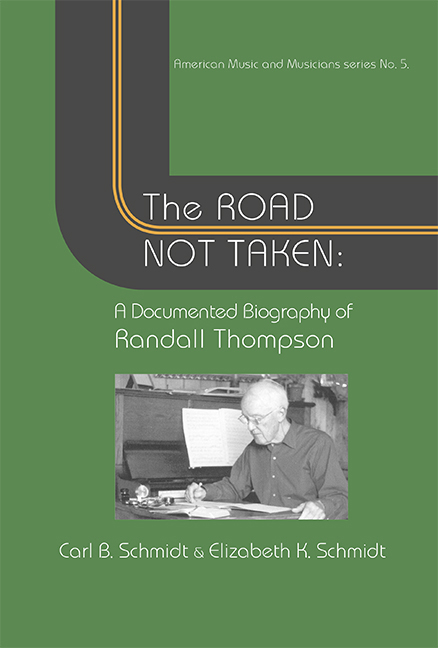Book contents
- Frontmatter
- Contents
- List of Illustrations
- List of Tables
- Library Sigla and Abbreviations
- Guide to Harvard University and Oberlin College Collections Referenced by Box Number
- Preface: Gateway to a Career
- Acknowledgments
- Chapter I Family History and Formative Years
- Chapter II Undergraduate Study at Harvard College (1916-20)
- Chapter III Lessons with Ernest Bloch and Graduate Study at Harvard University (1920-22)
- Chapter IV Damrosch Fellowship Years at the American Academy in Rome (1922-25)
- Chapter V Courtship and Marriage (1925-27)
- Chapter VI New York City—Wellesley College—A Guggenheim Fellowship (1927-31)
- Chapter VII Guest Conducting, Reception of Symphony no. 2, and College Music: An Investigation (1931-35)
- Chapter VIII Life after College Music: An Investigation (1935-37)
- Chapter IX The University of California at Berkeley (1937-39)
- Chapter X Curtis Institute of Music: The Hiring Process (Spring and Summer 1939)
- Chapter XI Curtis Institute (Fall 1939-Spring 1941)
- Chapter XII The University of Virginia (Fall 1941-Spring 1945)
- Chapter XIII Princeton University (Fall 1945-Spring 1948)
- Chapter XIV Return of a Favored Son: Harvard University (Fall 1948-Spring (1957)
- Chapter XV Harvard University (Summer 1957 to July 1, 1965)
- Chapter XVI The Early Retirement Years (1965-75)
- Chapter XVII The Final Years (1975-84)
- Chapter XVIII Recapitulation and Coda
- Bibliography of Works Cited by Abbreviations
- Index
Chapter III - Lessons with Ernest Bloch and Graduate Study at Harvard University (1920-22)
- Frontmatter
- Contents
- List of Illustrations
- List of Tables
- Library Sigla and Abbreviations
- Guide to Harvard University and Oberlin College Collections Referenced by Box Number
- Preface: Gateway to a Career
- Acknowledgments
- Chapter I Family History and Formative Years
- Chapter II Undergraduate Study at Harvard College (1916-20)
- Chapter III Lessons with Ernest Bloch and Graduate Study at Harvard University (1920-22)
- Chapter IV Damrosch Fellowship Years at the American Academy in Rome (1922-25)
- Chapter V Courtship and Marriage (1925-27)
- Chapter VI New York City—Wellesley College—A Guggenheim Fellowship (1927-31)
- Chapter VII Guest Conducting, Reception of Symphony no. 2, and College Music: An Investigation (1931-35)
- Chapter VIII Life after College Music: An Investigation (1935-37)
- Chapter IX The University of California at Berkeley (1937-39)
- Chapter X Curtis Institute of Music: The Hiring Process (Spring and Summer 1939)
- Chapter XI Curtis Institute (Fall 1939-Spring 1941)
- Chapter XII The University of Virginia (Fall 1941-Spring 1945)
- Chapter XIII Princeton University (Fall 1945-Spring 1948)
- Chapter XIV Return of a Favored Son: Harvard University (Fall 1948-Spring (1957)
- Chapter XV Harvard University (Summer 1957 to July 1, 1965)
- Chapter XVI The Early Retirement Years (1965-75)
- Chapter XVII The Final Years (1975-84)
- Chapter XVIII Recapitulation and Coda
- Bibliography of Works Cited by Abbreviations
- Index
Summary
Gaining the “libido sciendi”
(Randall Thompson)
ROGER SESSIONS AND STUDY WITH ERNEST BLOCH (1920-21)
Having graduated from Harvard with clear aspirations of becoming a com¬poser, Thompson had to think seriously about his future and chart a course. One Harvard student he had looked up to since their meeting in 1917 was Roger Sessions. Precocious to say the least, Sessions had entered Harvard at age fourteen in 1911 and completed his bachelor's degree in three years though hardly with a sterling academic record. He then went to Yale Univer¬sity to study with Horatio Parker in 1916, and by fall 1917 had been hired to teach at Smith College. In 1919 Sessions's old Harvard College friend John Burk—who had succeeded him as editor of the Harvard Music Review when Sessions received academic probation—was now program annotator for the BSO. Burk gave him tickets to a performance of Psalms 137 and 114 by Ernest Bloch (1880-1959), and soon thereafter Sessions arranged a meeting with Bloch.
First interviews with the renowned composer for would-be students had the reputation of being rather daunting. In Sessions's case, he had pur¬chased several scores before his initial appointment at Bloch's 955 Lexing¬ton Avenue, New York City apartment in order to become acquainted with Bloch's music. He brought with him his own Symphonic Prelude, and after a few pleasantries was beckoned to the piano. As Sessions later recalled:
He treated me very roughly. I wasn't prepared for this, but I did want someone on whom I could rely to give the whole business right from the shoulder. Afterwards he told me that he did that just to see whether I could take it or not. He had had other young people who came to study with him who could not. But that was what I wanted, and I told him so. I was in the clouds when I came out of that meeting. I wrote it all down in a diary, which I destroyed years ago. I wrote it all down word for word, and one day when Bloch was in my study, years later, I said, “Sit down. I want to read you something.” And I read him the whole thing. His jaw dropped, and he said, “You make it sound as if I didn't like your music.” I said, “You gave me no reason to think that you did.”
- Type
- Chapter
- Information
- The Road Not TakenA Documented Biography of Randall Thompson, 1899–1984, pp. 95 - 110Publisher: Boydell & BrewerPrint publication year: 2018

